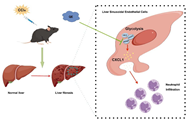Quercetin alleviates liver fibrosis via regulating glycolysis of liver sinusoidal endothelial cells and neutrophil infiltration
DOI:
https://doi.org/10.17305/bb.2024.10530Keywords:
Quercetin, liver fibrosis, glycolysis, liver sinusoidal endothelial cell, neutrophil infiltrationAbstract
Liver fibrosis, a common characteristic in various chronic liver diseases, is largely influenced by glycolysis. Quercetin (QE), a natural flavonoid known to regulate glycolysis, was studied for its effects on liver fibrosis and its underlying mechanism. In a model of liver fibrosis induced by carbon tetrachloride (CCl4), we aimed to assess pathological features, serum marker levels, and analyze the expression of glycolysis-related enzymes at both mRNA and protein levels, with a focus on changes in liver sinusoidal endothelial cells (LSECs). Our results showed that QE effectively improved liver injury and fibrosis evident by improved pathological features and lowered levels of serum markers, such as alanine aminotransferase (ALT), aspartate aminotransferase (AST), alkaline phosphatase (ALP), γ-glutamyl transferase (GGT), total bile acid (TBA), total bilirubin (TBIL), direct bilirubin (DBIL), hyaluronic acid (HA), laminin (LN), and procollagen type III (PCIII). QE also decreased lactate production and downregulated the expression of glycolysis-related enzymes—pyruvate kinase M2 (PKM2), phosphofructokinase platelet (PFKP), and hexokinase II (HK2)—at both the mRNA and protein levels. QE reduced the expression and activity of these enzymes, resulting in reduced glucose consumption, adenosine triphosphate (ATP) production, and lactate generation. Further analysis revealed that QE inhibited the production of chemokine (C-X-C motif) ligand 1 (CXCL1) and suppressed neutrophil recruitment. Overall, QE showed promising therapeutic potential for liver fibrosis by targeting LSEC glycolysis and reducing neutrophil infiltration.
Citations
Downloads

Downloads
Published
Issue
Section
Categories
License
Copyright (c) 2024 Xiaoying Chen, Yifan Wang, Jie Wan, Xiaoyun Dou, Chuzhao Zhang, Meng Sun, Fang Ye

This work is licensed under a Creative Commons Attribution 4.0 International License.









